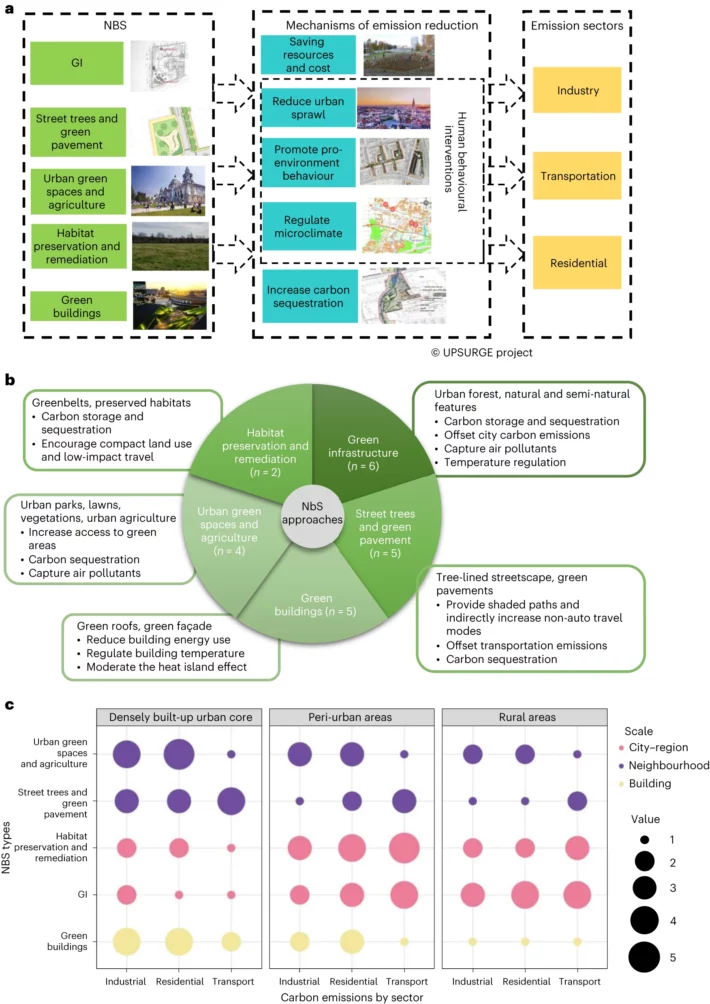
A recent analysis reveals the overlooked potential of urban nature-based solutions (NBS) in achieving carbon neutrality in major European cities. While phasing out fossil energy is vital, the spatial organization and utilization of NBS can significantly contribute to emission reductions. The study examined five NBS categories across 54 cities, discovering that, if effectively optimized, NBS could reduce carbon emissions by an average of 17.4%, with some cities potentially achieving carbon neutrality before 2030.
The impact varies among sectors, with green buildings and urban parks showing notable influence on industrial and residential emissions respectively. The research, published in Nature, underscores the importance of a comprehensive evaluation of NBS, considering socioeconomic and ecosystem contexts to maximize emission reductions and meet ambitious climate targets.
The potential of urban nature-based solutions in achieving carbon neutrality in major European cities is significant. These solutions, such as urban green spaces and urban agriculture, have been shown to contribute not only to carbon emissions reduction but also to carbon sequestration. The direct effects are the most commonly acknowledged benefits of NBS. However, the indirect effects on social and economic systems are often overlooked. These include promoting pro-environmental behaviors and reducing energy consumption in urban areas.
Direct and indirect impact of NBS
When discussing NBS, it is essential not to focus solely on the direct effects. For instance, while urban parks contribute to carbon sequestration, they also significantly influence residential carbon emissions by promoting healthier lifestyles and reducing the need for energy-intensive recreational activities. Similarly, green buildings absorb carbon and significantly reduce industrial carbon emissions by promoting energy efficiency and reducing the need for air conditioning.
Varied impact across sectors and cities
The effectiveness of NBS is not uniform across all sectors and cities. The analysis found that the impact of these solutions on carbon emissions varies between sectors, with green buildings having the most impact on industrial carbon emissions and urban parks and agriculture on residential emissions. Furthermore, the study found that the potential for emission reduction through NBS varies among cities. Some cities could achieve carbon neutrality before 2030 by maximizing NBS implementations on available land parcels, while others could significantly reduce emissions[1]. This indicates the need for a tailored approach to NBS implementation, considering each city’s unique socioeconomic and ecosystem contexts.
Case studies of NBS in action
Examples of successful implementation of NBS can be found across Europe. The proGIreg project, for instance, aims to transform post-industrial areas into biodiversity-rich green spaces, promoting urban farming and aquaponics for sustainable food production. Meanwhile, the URBiNAT project focuses on the social aspects, aiming to create a sense of community through local markets and blending natural and social elements. These projects aim to improve urban living conditions and well-being and enlist nature to address threats to food, water, biodiversity, human health, the economy, and the climate.
The role of local communities in NBS
One common thread across these projects is the significant role of local communities in designing and implementing NBS. Local citizens often make local food production economically viable through urban farming. In Turin, an urban farm in a post-industrial neighborhood has become a successful business, with volunteers running the farm and having a small shop on-site. Similarly, nature-based solutions are implemented in cities participating in the URBiNAT project to foster a sense of community and belonging.
Assessing the impact of NBS
To assess the impact of these initiatives, drones fitted with thermal imaging cameras are being used to determine the reduction in street-level temperatures achieved by newly planted trees and greenery. Surveys conducted with locals measure changes in socio-economic well-being before and after implementing nature-based solutions. These assessments help understand the direct and indirect effects of NBS on urban environments and their contribution to carbon neutrality.
The future of urban NBS
With the European Union pledging to decrease net emissions by 57% by 2030, involving 100 cities, NBS will play a crucial role in achieving this target. Although the current policy program does not address the opportunities for NBS to mitigate carbon emissions beyond direct sequestration, the studies and projects highlight the potential for a broader application of NBS. They underline the importance of integrating NBS into urban planning and development to achieve carbon neutrality and mitigate the impacts of climate change.


